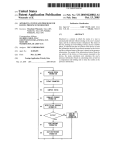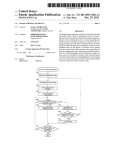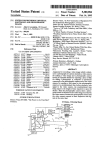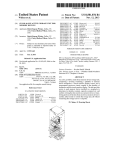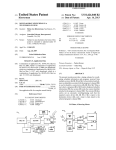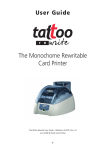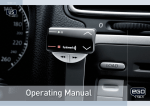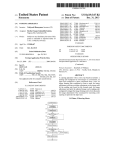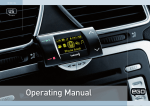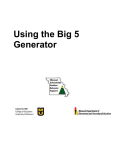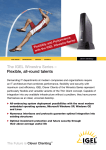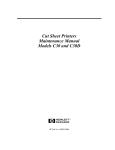Download Image forming apparatus that changes a permissible range of a
Transcript
US008582993B2 (12) United States Patent (10) Patent N0.: (45) Date of Patent: Murayama et a]. (54) IMAGE FORMING APPARATUS THAT CORRECTION VALUE / JP H08-262829 A 10 1996 JP 2002244393 2 A 8/2002 JP 2005234454 A 9/2005 JP 2010079125 A 2 4/2010 JP (75) Inventors: Kentaro Osamu Takahashi, Murayama,Nagoya Kasugai (JP)(JP); (73) Assignee: Nagoya'shl’ Brother Kogyo Alchl'ken Kabushiki (JP) Kaisha, Notice: Nov. 12, 2013 FOREIGN PATENT DOCUMENTS CHANGES A PERMISSIBLE RANGE OF A (*) US 8,582,993 B2 Subject to any disclaimer, the term of this patent is extended or adjusted under 35 U~S~C- 15403) by 201 days- H11-119504 A 4/1999 OTHER PUBLICATIONS Japan Patent Of?ce, Noti?cation of Reasons for Refusal for Japanese Patent Application No. 2010-146582 (counterpart to above-cap (21) Appl' NO‘: 13/072,823 (22) (65) Flled: tioned patent application), mailed Jul. 9, 2013. _ Japan Patent Of?ce, Decision on Rejection for Japanese Patent Appli Mar- 281 2011 Prior Publication Data Us 2011/0318032 A1 (30) cation No. 2010-146582 (counterpart to above-captioned patent application), mailed Sep. 10, 2013. Dec. 29, 2011 * Cited by examiner Foreign Application Priority Data J 28 2010 un. , (JP) Primary Examiner * Sophia S Chen 2010 146582 ............................... .. (51) Int. Cl. (57) G03G 21/00 (52) U 5 Cl ' ' (200601) ' ' (56) ABSTRACT An image forming apparatus is provided. The image forming apparatus includes: a manual acquiring unit Which is con?g ured to receive a user input to acquire a correction value; an _ _ UISPC ......... .... ...... ... .......... .. 399/49, 399/81, 399/301 (58) (74) Attorney, Agent, or Firm * Baker Botts L.L.P. - image forming unit Which is con?gured to form an image While adjusting at least one of positional deviation and den_ Fleld of Classl?catlon Search sity deviation of the image based on the correction value; and USPC a Changing unit which is Con?gured to execute at least one of .... ..~ ..................... .. 399/49, 301, '81; 347/116 See apphcanon ?le for Complete Search hlstory' References Cited a ?rst changing process of changing a permissible range of a correction value for positional deviation according to a status of a factor causing a change in a position of an image, and a second changing process of changing a permissible range of U.S. PATENT DOCUMENTS 6,335,747 B1 2008/0118257 A1 a correction value for density deviation according to a status of a factor causing a change in a density of an image. 1/ 2002 Munakata 5/2008 Murakami 2008/0279599 A1* 11/2008 Nagatsuka .................. .. 399/301 2010/0086317 A1* 4/2010 Kadokura ..................... .. 399/11 13 Claims, 9 Drawing Sheets MANUALACQUIRING PROCESS READ OUT CORRECTION VALUES AOQUIRE DATA OF FACTOR CAUSING CHANGE CALCULATE PERMISSIBLE RANGE PRINT PATTERN IMAGE 1 INSTRUCTION TO COMPL7ETE INPUT YES S107 ACQUIRE INPUT VALUE S106 UPDATE MANUAL CORRECTION VALUE CANCEL INgTRUCTION US. Patent Nov. 12, 2013 Sheet 1 of9 US 8,582,993 B2 FIG. 1 100 / MFP 30 / CONTROL UNIT 35 / 31 A cPu <——> 32 ROM ‘—’ < IMAGE FORMING UNIT ~ 10 33-» RAM ‘w’ 4 > IMAGE READING UNIT ~20 ASIC 34’ NVRAM 37 v" FAX HF ‘_’ 36*’- NETWORK l/F 4-’ <—-A OPERATION PANEL ~40 US. Patent Nov. 12, 2013 Sheet 2 of9 US 8,582,993 B2 FIG. 2 100 40 I i 50M3 7 \50Y 3 50C 5 50K’ 71 a; 'J US. Patent 3 FIG. Nov. 12, 2013 Sheet 3 of9 US 8,582,993 B2 US. Patent Nov. 12, 2013 Sheet 4 of9 US 8,582,993 B2 US. Patent Nov. 12, 2013 Sheet 5 of9 US 8,582,993 B2 FIG. 5 (MANUALACQUIRING PROCESS) II READ OUT CORRECTION VALUES ~ $101 II ACQUIRE DATA OF FACTOR ~ $102 CAUSING CHANGE II CALCULATE PERMISSIBLE RANGE ~ S103 II ADJUST PERMISSIBLE RANGE ~ 8104 I PRINT PATTERN IMAGE 3106 ~ $105 I INSTRUCTION TO COMPL7ETE INPUT YES S107 v‘ S111 ACQUIRE INPUT VALUE II S108 _,_ UPDATE MANUAL CORRECTION VALUE END CANCEL INSTRUCTION ? YES US. Patent Nov. 12, 2013 Sheet 6 of9 US 8,582,993 B2 FIG. 6 341 \ THE NUMBER OF PRINTED PAGES ASSUMED EXPANSION AMOUNT 1 - 1 O O O O 1 OO 1 - 2 O O O 2 2 OO 1 - 3 O O O 4 3 OO 1 - 4 O O O 6 4 O O 1 - 8 FIG. 7 342 \ TEMPERATURE DIFFERENCE O - 1 O 1 1 ASSUMED EXPANSION AMOUNT O - 1 5 1 1 6 - 2 O 2 2 1 - 2 5 3 2 6 - 4 US. Patent Nov. 12, 2013 Sheet 7 of9 n N _.T aw. US 8,582,993 B2 US. Patent NOV. 12, 2013 US 8,582,993 B2 Sheet 8 0f 9 FIG. 9 @UTOMATIC ACQUIRING PROCESS) I READ OUT CORRECTION VALUES I FORM REGISTRATION PATTERN ~ S202 II DETECT REGISTRATION PATTERN ~ S203 V CALCULATE AMOUNT OF DEVIATION ~ S204 S205 AMOUNT OF DEVIATION IS WITHIN PREDETERMINED RANGE’? YES I UPDATE AUTOMATIC CORRECTION VALUE v YES ADJUSTMENT COLOR THAT HAS NOT YET DETERMINED REMAINS? NOTIFY ERROR ~ $211 US. Patent NOV. 12, 2013 US 8,582,993 B2 Sheet 9 0f 9 FIG. 10 ( PRINTING PROCESS ) I READ OUT CORRECTION VALUES 7 ACQUIRE IMAGE DATA -- S302 7 FORM IMAGE 7 (END) ~ S303 US 8,582,993 B2 1 2 IMAGE FORMING APPARATUS THAT CHANGES A PERMISSIBLE RANGE OF A CORRECTION VALUE folloWing description of illustrative embodiments of the present invention taken in conjunction With the attached draWings, in Which: CROSS-REFERENCE TO RELATED APPLICATION tion of an MFP; FIG. 2 shoWs a schematic con?guration of an image form FIG. 1 is a block diagram shoWing an electrical con?gura ing unit of the MFP shoWn in FIG. 1; This application claims priority from Japanese Patent FIG. 3 shoWs an arrangement of mark sensors; FIGS. 4A and 4B shoW a printing example of a pattern Application No. 2010-146582, ?led on Jun. 28, 2010, the entire subject matter of Which is incorporated herein by ref image; erence. FIG. 5 is a How chart shoWing a sequence of a manual acquiring process; TECHNICAL FIELD FIG. 6 shoWs a printed page number limiting table; FIG. 7 shoWs a temperature limiting table; FIG. 8 shoWs a printing example of a pattern image on Aspects of the present invention relate to an image forming apparatus that adjusts a position or density of an image based Which a current correction value is re?ected; FIG. 9 is a How chart shoWing a sequence of an automatic on a correction value input by a user. acquiring process; and BACKGROUND An image forming apparatus performs an image adjust 20 FIG. 10 is a How chart shoWing a sequence of a printing process. ment so that a position or density of an image is not deviated. DETAILED DESCRIPTION For example, an image forming apparatus has been knoWn Which receives a correction value input by a user through an operation panel or a printer driver and performs an image adjustment of adjusting positional deviation or density devia 25 tion based on the correction value When forming an image. JP-A-2005-234454 describes a technique of acquiring the correction value by the user input, Which includes printing a pattern image for positional deviation correction on a sheet and alloWs a user to determine and input a correction value based on a printing result thereof. function. 30 However, the above image forming apparatus has a folloW ing problem. That is, in the image forming apparatus that acquires the correction value by the user input, When the input correction value is considerably inappropriate, a quality of an Hereinafter, an image forming apparatus and an image forming system according to illustrative embodiments Will be described With reference to the accompanying draWings. In the illustrative embodiments, the present invention is applied to a multi function peripheral (MFP) having a color printing 35 image may be remarkably deteriorated. [Con?guration of MFP] As shoWn in FIG. 1, an MFP 100 of this illustrative embodiment includes a control unit 30 having a CPU 31, a ROM 32, a RAM 33, an NVRAM (non-volatile RAM) 34, an ASIC 35, a netWork interface 36 and a FAX interface 37. In addition, the control unit 30 is electrically connected to an image forming unit 10 that forms an image on a sheet, an image reading unit 20 that reads out an image of a sheet and an operation panel 40 that displays an operation situation and SUMMARY receives an input operation by a user. Accordingly, it is an aspect of the present invention to provide an image forming apparatus that can suppress per forms an image adjustment based on a correction value input by a user and can suppress a quality of an image from being deteriorated. According to an illustrative embodiment of the present 40 an image adjustment function (described later), and functions as a center of control. The ROM 32 stores therein various 45 receive a user input to acquire a correction value; an image deviation of the image based on the correction value; and a changing unit Which is con?gured to execute at least one of a ?rst changing process of changing a permissible range of a correction value for positional deviation according to a status of a factor causing a change in a position of an image, and a control programs for controlling the MFP 100, various set tings, initial values and the like. The RAM 33 is used as a Work area from Which the various control programs are read out or a storage area that temporarily stores image data. The NVRAM 34 is a non-volatile storage device and is used as a invention, there is provided an image forming apparatus com prising: a manual acquiring unit Which is con?gured to forming unit Which is con?gured to form an image While adjusting at least one of positional deviation and density The CPU 31 executes operations for implementing various functions such as an image reading function, an image form ing function, a FAX data transmission/reception function and 50 storage area that preserves various settings, image data and the like. Based on the control programs read out from the ROM 32 or signals transmitted from various sensors, the CPU 31 con 55 trols the respective constitutional elements of the MFP 100 (for example, a turn-on timing of an exposure device con?g second changing process of changing a permissible range of uring the image forming unit 10, driving motors of various a correction value for density deviation according to a status of a factor causing a change in a density of an image. rollers con?guring a conveyance path of a sheet and a moving motor of an image sensor unit con?guring the image reading unit 20) through the ASIC 35 While storing results of the According to the above con?guration, there is provided an based on a correction value input by a user and can suppress processing in the RAM 33 or NVRAM 34. The netWork interface 36 is connected to a netWork and a quality of an image from being deteriorated. enables connection With the other information processing image forming apparatus that performs an image adjustment 60 BRIEF DESCRIPTION OF THE DRAWINGS 65 The above and other aspects of the present invention Will become more apparent and more readily appreciated from the apparatuses. The FAX interface 37 is connected to a tele phone line and enables connection With a FAX apparatus of the other party. The MFP 100 performs data communication With an external apparatus through the netWork interface 36 or FAX interface 37. US 8,582,993 B2 4 3 [Con?guration of Image Forming Unit] device 8 With respect to the conveyance direction of the sheet and detects a pattern for image adjustment formed on the conveyance belt 7. Speci?cally, as shoWn in FIG. 3, the mark sensor 61 Next, a con?guration of the image forming unit 10 of the MFP 100 Will be described With reference to FIG. 2. The image forming unit 10 has a process unit 50 that forms a toner includes tWo sensors, i.e., a sensor 61R that is arranged at a right side of a Width direction of the conveyance belt 7 and a sensor 61L that is arranged at a left side thereof. Each of the sensors 61R, 61L is a re?ection-type optical sensor having a image by an electro-photographic method and transfers the toner image on a sheet, a ?xing device 8 that ?xes un?xed toner on the sheet, a sheet feeding tray 91 that accommodates sheets therein before the image transfer and a sheet discharge tray 92 Which receives sheets thereon after the image transfer. pair of a light emitting element 62 (for example, LED) and a light receiving element 63 (for example, photo transistor). The image reading unit 20 is arranged above the image form ing unit 10. The mark sensor 61 illuminates light to a surface (dotted ranges E in FIG. 3) of the conveyance belt 7 in an oblique The image forming unit 10 has an exposure device 53 that direction by the light emitting elements 62 and receives the illuminates light to the respective process units 50Y, 50M, light by the light receiving elements 63, respectively. The 50C, 50K, a conveyance belt 7 that conveys a sheet to transfer and a mark sensor 61 that detects a pattern image formed on mark sensor can detect a mark 66 for image adjustment (mark 66 of FIG. 3 is an example of a mark for positional deviation correction) by a difference betWeen an amount of re?ection the conveyance belt 7. light received When the mark for image adjustment passes and positions of the respective process units 50Y, 50M, 50C, 50K In addition, the image forming unit 10 is provided therein With a conveyance path 11 (one dotted and dashed line in FIG. 2) having a substantial S shape so that the sheet accommo dated in the sheet feeding tray 91 positioned at a bottom passes through a feeder roller 71, registration rollers 72, the process unit 50 and the ?xing device 8 and is then guided to 20 the sheet discharge tray 92 through sheet discharge rollers 76. 25 [Image Adjustment in MFP] Next, the image adjustment in the MFP 100 Will be described. In the MFP 100, regarding the image adjustment, a positional deviation correction that adjusts positions of The process unit 50 can form a color image and includes the process units corresponding to respective colors of yelloW (Y), magenta (M), cyan (C) and black (K) in parallel. Spe ci?cally, the process unit 50 has the process unit 50Y that forms an image of aY color, the process unit 50M that forms 30 an image of an M color, the process unit 50C that forms an image of a C color and the process unit 50K that forms an after, the image adjustment Will be described With reference 35 veyance direction of the sheet. In the process unit 50, a surface of a photosensitive member is uniformly charged by a charging device. Then, the photo sensitive member is exposed by the light from the exposure device 53 and an electrostatic latent image corresponding to 40 an image formed on a sheet is thus formed on the photosen 45 In the manual correction, a user inputs a numerical value through the operation panel 40, so that a correction value is manually acquired. 50 for positional deviation correction are formed by the respec tive process units 50Y, 50M, 50C, 50K. The execution con 55 to the sheet. At this time, for a case of a color printing, toner images are formed by the respective process units 50Y, 50M, The mark sensor 61 is provided doWnstream from the pro cess units 50Y, 50M, 50C, 50K and upstream from the ?xing dition is determined based on an elapsed time period after a previous acquiring process, the number of printed pages, environmental changes such as temperature and humidity and unit 10 transfers the toner image formed in the process unit 50 after the ?xing is discharged to the sheet discharge tray 92. Here, a sequence of acquiring the correction value in the automatic correction Will be described. First, When a prede termined execution condition is satis?ed, registration patterns dated in the sheet feeding tray 91 one by one and conveys the 50C, 50K and are then overlapped With each other on the sheet. In the meantime, for a case of a monochrome printing, a toner image is formed only by the process unit 50K and is then transferred on the sheet. Thereafter, the sheet on Which the toner images are transferred is conveyed to the ?xing device 8 and is then heat-?xed on the sheet. Then, the sheet thus calculates an amount of deviation. A correction value based on the amount of deviation is automatically acquired. the conveyance belt is conveyed from the registration rollers 72 toWard the ?xing device 8. The image forming unit 10 picks up the sheets accommo sheet onto the conveyance belt 7. Then, the image forming rection Will be described. The MFP 100 has tWo modes of acquiring process, Which includes an automatic correction and a manual correction. The automatic correction is to adjust an image to an ideal position that is set for the MFP 100. The manual correction is to re?ect a user’s preference or to sub stitute for the automatic correction When the automatic cor rection does not function properly. In the automatic correction, a registration pattern that is a pattern image for detecting an amount of positional deviation and the mark sensor 61 detects the registration pattern and sitive member. Then, toner is supplied to the photosensitive member through a developing device. Thereby, the electro static latent image on the photosensitive member becomes a visible image as a toner image. The conveyance belt 7 is an endless belt member that is Wound around the conveyance rollers 73, 74 and is made of a resin material such as polycarbonate and the like. The con veyance belt 7 is rotated in a counterclockwise direction as the conveyance roller 74 is rotated. Thereby, the sheet put on images of the respective colors and a density deviation cor rection that adjusts densities of the respective colors are per formed. Both image adjustments include an acquiring pro cess of acquiring amounts of deviation of adjustment colors from a reference color and acquiring correction values speci ?ed by the amounts of deviation and a correcting process of correcting an image based on the correction values. Herein to the positional deviation correction. First, the acquiring process of the positional deviation cor image of a K color. The respective process units 50Y, 50M, 50C, 50K are arranged at a predetermined interval in a con an amount of re?ection light received that is directly received from the conveyance belt 7. a remaining amount of toner, for example. Speci?cally, as shoWn in FIG. 3, the registration pattern 66 60 includes a mark group Which has a mark 66K formed by the process unit 50K, a mark 66C formed by the process unit 50C, a mark 66M formed by the process unit 50M and a mark 66Y formed by the process unit 50Y, Which are arranged in a sub-scanning direction. 65 The registration pattern 66 is formed at a constant interval in the sub-scanning direction (a moving direction of the con veyance belt 7 shoWn in FIG. 3). Each of the marks 66K, 66C, US 8,582,993 B2 5 6 66M, 66Y has a rectangular rod shape and is long in a main reference color and the mark of the adjustment color are not matched at the Zero position and are matched at —3 position. Thereby, a user can recogniZe that positional deviation of 3 scanning direction (direction perpendicular to the sub-scan ning direction). Next, based on digitiZed signals output from the mark sensor 61, positions of the respective marks 66K, 66Y, 66M, 66C are detected. Then, intervals of marks (for example, marks 66C, 66M, 66Y) of respective adjustment colors rela dots occurs in the left. In this case, the user can adjust the positional deviation of the C color by inputting ‘3’ as a cor rection value. When positional deviation of 3 dots occurs in the right, the user inputs ‘—3’ as a correction value. In this illustrative embodiment, the K color is the reference color and the user can also input correction values for the M and Y colors in the same manner, in addition to the C color. tive to a mark of a reference color (for example, mark 66K) in the sub-scanning direction are respectively calculated. The intervals betWeen the mark of the reference color and the adjustment colors are changed When positional deviation occurs in the sub-scanning direction. Therefore, it is possible In the meantime, the con?guration of the pattern image 86 is just illustrative and is not limited to the above. The pattern image may be a general image pattern that is used to correct the positional deviation. For example, the mark group includ ing the pattern image 86 is formed at a constant interval in the sub-scanning direction (vertical direction in FIG. 4A), so that to specify an amount of deviation of the adjustment color relative to the reference color in the sub-scanning direction. Based on the amount of deviation, a correction value by the automatic correction (hereinafter, referred to as “automatic correction value”) is calculated. The automatic correction a user can check the positional deviation of the sub-scanning direction. values are stored in the NVRAM 34. The printing of the pattern image 86 is executed When the It is noted that the con?guration of the registration pattern 66 is just illustrative and is not limited to the above. The 20 sWitch button is pushed. Accordingly, a user can determine a registration pattern may be a general image pattern that is correction value by referring to the sheet on Which the pattern used to correct the positional deviation. For example, the registration pattern may include a pair of tWo rod-shaped image 86 is printed. In the meantime, it may be also possible that the operation panel 40 is provided With a button for printing a pattern image and a user prints the pattern image 86 at any timing. marks Wherein at least one is inclined by a predetermined angle to a straight line folloWing the main scanning direction. 25 Such registration pattern can specify an amount of deviation in the main scanning direction as Well as in the sub-scanning direction. In the meantime, the manual correction is executed by a user’s operation. The operation panel 40 is provided With a sWitch button for sWitching into a manual correction mode that enables an input of a correction value. A user pushes the sWitch button, inputs a desired correction value and then pushes an OK button. When the OK button is pushed, the MFP 100 acquires the input value to release the manual correction mode. Based on the input value, a correction value by the manual correction (hereinafter, referred to as “manual correction value”) is calculated. The manual correction value is stored in the NVRAM 34. The MFP 100 has a pattern printing function of printing a In the correction process, an actual correction value is determined by using the automatic correction value and the manual correction value, Which are stored in the NVRAM 34. Based on the actual correction value, process conditions (for 30 so that a position of an image of the adjustment color is matched With a position of an image of the reference color. In the meantime, the density deviation adjustment also 35 40 is printed. 45 marks of the same color having a rectangular rod shape are formed at a constant interval in the main scanning direction correction, a manual correction value can be received through rection value is calculated based on the correction values, and 50 adjustment color are narroWer than that of the marks 86K of ment color is the same as the number of the marks of the reference color and a Zero mark is printed so that its position of the main scanning direction is matched With a Zero mark of the reference color. FIG. 4A shoWs a case Where positional deviation does not occur and the mark of the reference color and the mark of the adjustment color are matched at a Zero position. FIG. 4B shoWs a printing example Where positional devia tion occurs by 3 dots to the left. In this case, the mark of the are calculated as automatic correction values. In the manual a user input. Then, in the correction process, an actual cor (horizontal direction in FIG. 4A). In the example of FIG. 4A, the reference color is black (K color) and the adjustment color the reference color by n dots (n is natural number and n:l in this illustrative embodiment). The marks 86K of the reference color are formed as the number (25 in FIGS. 4A and 4B) corresponding to a permissible range of the manual correc tion value for the adjustment color and numbers (—12 to 12 in FIG. 4) corresponding to the permissible range are added in ascending order from the left. The marks 86C of the adjust detected by the common sensor to the positional deviation correction or another optical sensor. In this illustrative embodiment, the detection is performed by the sensor 61L, for example. According to the amounts of re?ected light, the densities are speci?ed and differences With a target density FIG. 4A or 4B (hereinafter, referred to as “pattem image 86”) is cyan (C color) and an interval of the marks 86C of the includes the automatic correction and the manual correction. For example, in the automatic correction, density patterns having density differences in the sub-scanning direction are formed by the respective process units 50Y, 50M, 50C, 50K. Then, amounts of re?ected light from the density patterns are pattern image that is referred to When a user inputs a correc tion value. As the pattern image, a mark group as shoWn in In the pattern image 86 of this illustrative embodiment, example, exposure position, speed of the conveyance belt 7 or photosensitive member) of the adjustment color are adjusted the process conditions (for example, exposure intensity, exposure range and developing bias) of the respective colors are adjusted to maintain a target density based on the actual correction value. [Sequence of Changing Permissible Range of Manual Cor rection Value] 55 The MFP 100 has a function of changing a permissible range of the manual correction value according to statuses of factors causing a change in a position or density of an image. In the folloWing, a sequence of changing the permissible range of the manual correction value Will be described 60 together With a sequence of executing the positional deviation correction. [Manual Acquiring Process] 65 A sequence of the manual acquiring process that is an acquiring process for manual correction Will be described With reference to a How chart of FIG. 5. The manual acquiring process is executed by the CPU 31 When the sWitch button provided to the operation panel 40 is pushed. US 8,582,993 B2 8 7 and closing the cover)+(T><change in tempera First, the automatic correction value and the manual cor rection value are read out from the NVRAM 34 (S101). Then, data is acquired, Which indicates the statuses of the factors ture)+(B><the number of rotations of the belt driv ing droller)+(S><maximum acceleration) (1) In the equation, C, T, B and S are coef?cients for calculat causing a positional deviation of an image (S102). Speci? cally, the number of printed pages and the temperature in the ing the individual expansion amounts of the respective fac apparatus are acquired. Then, a permissible range of the manual correction value is calculated based on the data acquired in S102 (S103). In this tors. Speci?cally, C indicates an amount of positional devia tion per one time of opening and closing the cover, T indicates an amount of positional deviation per unit temperature, B indicates an amount of positional deviation per one rotation of the driving roller 74 of the conveyance belt 7 and S indicates an amount of positional deviation per unit acceleration (unit illustrative embodiment, an initial value of a permissible range is stored in the ROM 32. In S103, an assumed expan sion amount of positional deviation is calculated based on the data acquired in S102 and adds the assumed expansion voltage). The C, T, B and S may be ?xed values or changed according to the other variables. In addition, the parameters applied to the equation (1) are not limited to the number of times of opening and closing the cover and the like. In addition, the permissible range of the manual correction value is determined for each of the adjustment colors. In other Words, the more distant from the transfer point of the refer amount to the initial value. Speci?cally, the MFP 100 has a printed page number lim iting table 341 that stores an assumed expansion amount a permissible range With respect to the number of printed pages, Which is shoWn in FIG. 6, and a temperature limiting table 342 that stores an assumed expansion amount of a permissible range With respect to the temperature in the appa ratus, Which is shoWn in FIG. 7. ‘The number of printed pages’ is typically the number of printed pages from a previ ence color, the amount of deviation tends to be greater, such as 20 the speed difference of the conveyance belt 7, the temperature ous update of the manual or automatic correction value. difference in the apparatus and the like. Therefore, the more distant from the reference color, the permissible range is set to Accordingly, the number of printed pages from the previous be larger. For example, in this illustrative embodiment, the K update is reset When the automatic correction value is updated. In addition, the temperature limiting table 342 color is the reference color and the adjustment colors are more 25 distant from the K color in order of C, M andY colors (refer to FIG. 2). Accordingly, ‘I’ is added to the total expansion amount of positional deviation in the M color and ‘2’ is added to the total expansion amount of positional deviation in theY 30 permissible range and the total expansion amount of posi tional deviation acquired from the respective tables is ‘3,’ the permissible range of the C color is —l3 to 13 dots, the per de?nes the assumed expansion amount for each of tempera ture differences betWeen a reference temperature, Which is a temperature in the apparatus at the time of the previous update, and the current temperature in the apparatus. Then, the assumed expansion amount corresponding to the current number of printed pages and the assumed expansion amount corresponding to the current temperature in the appa color. Thereby, When —10 to 10 dots are the initial value of the missible range of the M color is —14 to 14 dots and the permissible range of theY color is —15 to 15 dots. ratus, and both the assumed expansion amounts are summed up. For example, providing that the number of printed pages is 1,500 pages and the difference betWeen the temperature in the apparatus and the reference temperature is 11 degree C., the assumed expansion amount ‘2’ is acquired from the printed page number limiting table 341 and the assumed 35 After calculating the permissible ranges in S103, the per missible range is adjusted by using the current automatic and manual correction values that are acquired in S101 (S104). For example, providing that an image adjustment of ‘—3 dots’ 40 calculated by the automatic and manual correction values, When the permissible range acquired in S103 is —12 to 12 is performed based on the current actual correction value expansion amount ‘ l ’ is acquired from the temperature lim iting table 342, respectively. That is, the summed value ‘3’ of both the assumed expansion amounts Would be a total assumed expansion amount of positional deviation. Then, the dots, an actual correctable range is —9 to 15 dots. Accordingly, When —10 is input, for example, since the shift of ‘ —3 dots’ has permissible range of the manual correction value is deter mined While re?ecting the total assumed expansion amount of positional deviation. For example, if —10 to 10 dots is an initial value of the permissible range, the permissible range been already scheduled, the total amount of correction Would be —l3, Which exceeds the permissible range. Thus, in this illustrative embodiment, the permissible range is adjusted to Would be —l3 to 13 dots. ‘—9 to 15 dots’ so that a value equal to or smaller than ‘—10’ In the meantime, the parameter indicating the status of the factor causing the positional deviation in the image are not limited to the number of printed pages and the temperature in the apparatus. For example, an amount of change may be determined by ON time period, humidity in the apparatus, a remaining amount of toner, the number of times of opening cannot be input. After that, the pattern image 86 is printed on a sheet (S105). The number of marks of each color in the pattern image 86 is different according to the permissible ranges determined in S103. In addition, since the adjustment is performed on the basis of the current correction value in S104, the number of marks may be different in positive and negative sides. In the above example, by the adjustment in S104, the nega 50 and closing the cover and the like. Further, regarding the method of acquiring the total assumed expansion amount of the positional deviation, in addition to the method of preparing tables corresponding to the respective factors and referring to the tables to acquire the 55 tive number side is limited up to —9, and the marks are printed up to —9, so that it is expected that an inappropriate numerical value is prevented from being input. HoWever, When the posi assumed expansion amount for each of the factors, a calcula tive number side is printed up to 15, it may cause a user to misunderstand that a numerical value Within a range of —l 5 to tion equation for calculating a total assumed expansion amount of positional deviation may be prepared and then a total assumed expansion amount of positional deviation may be calculated based on a plurality of factors. For example, a total assumed expansion amount of positional deviation may be calculated by a folloWing equation (1). A total assumed expansion amount of positional deviation:(C><the number of times of opening 65 15 dots can be input. Accordingly, the number of marks to be printed is made to be Within the range determined in S103 (—12 to 12 dots in the above example). In other Words, in the above example, as shoWn in FIG. 8, marks of —9 to 12 are printed. After S105, an input of a correction by a user is Waited. The user inputs a correction value With the operation panel 40. US 8,582,993 B2 9 10 a position of a mark, for example. In addition, When the After that, it is determined Whether an instruction to com plete the input of the correction value is input (S106). When conveyance belt 7 has a damaged part and the mark sensor 61 an instruction to complete the input of the correction value is not input (S106: NO), it is determined Whether a cancel instruction is input (S111). When a cancel instruction is also not input (S111: NO), the process returns to S106. When a falsely detects the damaged part as a mark, an inappropriate amount of positional deviation can be caused. Also, When the mark sensor 61 is out of order, even the amount of positional deviation itself cannot be acquired. For an adjustment color having an amount of positional cancel instruction is input (S111: YES), the manual acquiring process ends. When an instruction to complete the input of the correction deviation that is Within the predetermined range (S205: YES), the automatic correction value corresponding to the adjust ment color is updated (S206). Speci?cally the amount of positional deviation acquired in S204 is added to the current automatic correction value, and the result is stored in the value is input (S106: YES), the input values of the respective adjustment colors are acquired, Which are input as correction values (S107). Accordingly, the manual correction values of the respective adjustment colors are updated (S108). Speci? NVRAM 34 as a neW automatic correction value. In the cally, the input value is added to the current manual correction meantime, When the automatic correction value is updated, value, and the result is stored in the NVRAM 34 as a neW manual correction value. After S108, the manual acquiring process ends. In the meantime, if a numerical value exceeding the per missible range has been input When an instruction to com plete the input of the correction value is input, a message is issued indicating that there is a false input and again an input 20 of positional deviation that exceeds the predetermined range of a correction value is Waited. Alternatively, When a numeri (S205: NO), an error is noti?ed, Which indicates that the automatic correction value is failed to be acquired (S211). cal value exceeding the permissible range is input, the numerical value exceeding the permissible range may be replaced With a value Which is most close to the input value The noti?cation modes include message display on a display 25 but Within the permissible range. Further, it may be prohibited to input a numerical value exceeding the permissible range at a step before an instruction to complete the input of the correction value. [Automatic Correction Process] After S206 or S211, it is determined Whether an adjustment When an adjustment color that has not yet determined is 30 described With reference to a How chart of FIG. 9. The auto remaining (S207: YES), the process returns to S205 and determines the amount of positional deviation of the adjust ment color that has not yet been determined. When the deter mination of S205 is completed for all adjustment colors (S207: NO), the automatic acquiring process ends. matic acquiring process is executed by the CPU 31 When an 35 [Printing Process] Next, a sequence of the printing process of printing image data Will be described With reference to a How chart of FIG. 40 10. The printing process is executed by the CPU 31 When a print instruction is received from the operation panel 40 or a print job is received from an information processing appara tus connected to the MFP 100. First, the automatic correction value and the manual cor rection value are read out from the NVRAM 34 (S301). Then, for each apparatus When manufacturing the apparatus and is image data to be printed is acquired (S302). The processes of stored in the ROM 32 before shipment. The initial amount of deviation is set as the initial value of the automatic correction value. In other Words, the automatic correction value is a unit of the operation panel 40, generation of an alarm sound and Writing of an error log, for example. color that has not yet determined is remaining in S205 (S207). Next, a sequence of the automatic acquiring process that is an acquiring process for automatic correction Will be execution condition Which is determined for automatic cor rection in advance is satis?ed. First, the automatic correction value and the manual cor rection value are read out from the NVRAM 34 (S201). The MFP 100 stores in the ROM 32, an amount of positional deviation before shipment from a factory, as an initial amount of deviation. The initial amount of deviation is an amount of positional deviation that is inherent to an apparatus measured the number of printed pages is reset to Zero. Accordingly, the assumed expansion amount With respect to the number of printed pages Would be Zero and the permissible range of the manual correction value is thus narroWed. In the meantime, for an adjustment color having an amount 45 S301 and S302 may be executed in a reverse order or at the same time. value having the initial amount of deviation added thereto. In Then, an actual correction value is determined by using the meantime, Zero (0) is set as an initial value of the manual both the automatic correction value and the manual correction value, Which are read out in S301, and an image is formed correction value. Then, the registration pattern 66 is formed on the convey ance belt 7 by using the automatic correction value and the manual correction value, Which are read out in S201 (S202). Then, the mark sensor 61 detects the registration pattern 66 (S203). Then, the amounts of positional deviations of the respective adjustment colors are calculated based on signals from the mark sensor 61 (S204). Then, it is determined Whether the amount of positional deviation of each adjustment color, Which is obtained in S204, is Within a predetermined range (S205). The predetermined range is a range Within Which the positional deviation can be adjusted and is stored in the ROM 32 in advance. The case 50 While adjusting the process conditions of the adjustment col ors so that positions of images of the adjustment colors are 55 60 matched at positions of images of the reference color (S303). After S303, the printing process ends. As described above, in the MFP 100 according to the illustrative embodiment, the permissible range is set for the manual correction value and is changed according to the factor (the number of printed pages, temperature in the appa ratus and the like) causing a change in a subject of the image adjustment. When inputting the manual correction value, a value Within the permissible range thereof is received, so that an appropriate manual correction value is acquired. In addi Where the amount of positional deviation exceeds the prede tion, When printing the pattern image 86, a pattern image termined range includes a case Where the amount of posi tional deviation is so large that the adjacent marks are over suitable for the permissible range thereof is printed, so that it is expected that an appropriate manual correction value is input. As a result, it is possible to avoid acquiring an inappro lapped With each other, for example. This kind of large 65 amount of positional deviation could be caused by an error priate correction value and to thus suppress a quality of an input of the manual correction value by a user, Which changes image from being deteriorated. US 8,582,993 B2 11 12 While the present invention has been shown and described With reference to certain illustrative embodiments thereof, it Will be understood by those skilled in the art that various changes in form and details may be made therein Without departing from the spirit and scope of the invention as de?ned correction value; an image forming unit Which is con?gured to form an image While adjusting at least one of positional deviation and density deviation of the image based on the correction value; and a changing unit Which is con?gured to by the appended claims. permissible range of a correction value for positional devia For example, the image forming apparatus is not limited to the MFP. In other Words, the inventive concept of the present invention can be applied to any apparatus having a printing function such as printer, copier, FAX apparatus and the like. In addition, the image forming apparatus is not limited to an electro-photographic type and may be an inkj et type. Further, tion according to a status of a factor causing a change in a the MFP 1 00 of the illustrative embodiment is a direct transfer tandem type. HoWever, the MFP may be an intermediate using a correction value input by a user (manual correction value). According to a status of a factor causing positional execute at least one of a ?rst changing process of changing a position of an image, and a second changing process of changing a permissible range of a correction value for density deviation according to a status of a factor causing a change in a density of an image. The above image forming apparatus forms an image by deviation and density deviation, the image forming apparatus transfer type or 4-cycle type. In the above illustrative embodiment, the MFP has the color printing function. HoWever, the inventive concept of the present invention can also be applied to a monochrome print ing apparatus inasmuch as it performs the positional deviation correction or density deviation correction. In the above illustrative embodiment, the pattern image is printed on the sheet When performing the manual acquiring process. HoWever, a con?guration of receiving an input from a user Without performing such printing may be also possible. In addition, When printing the pattern image, a type of the sheet may be designated. In the above illustrative embodiment, the actual correction value is determined by using the automatic correction value and the manual correction value. HoWever, the present inven tion is not limited thereto. For example, it may be possible to 20 according to a status of a factor causing a change in a position of an image and a second changing process of changing a permissible range of a correction value for density deviation according to a status of a factor causing a change in a density 25 of an image. The factor causing the change in the position or density of an image may include an operation amount and environmental changes such as temperature and humidity. That is, in the above image forming apparatus, there are permissible ranges of the manual correction values for each of 30 subjects (position and density of an image, for example) of the image adjustment and the permissible ranges of the manual correction values corresponding to the subjects of the image adjustment are changed according to the statuses of the factors causing the change in the subjects of the image adjust 35 ment. Therefore, When inputting a correction value, a value Within the permissible range thereof is received, so that an determine an actual correction value Without using the cor rection value having older update date betWeen the automatic and manual correction values. In this case, the registration pattern 66 in the automatic correction or pattern image 86 in the manual correction are prepared Without using the correc tion value having the older update date. In the above illustrative embodiment, the permissible range is determined When sWitching to the manual correction mode or When printing the pattern image 86. HoWever, the timing of changing the permissible range is not limited thereto. For example, it may be possible that a database, in Which the permissible ranges is stored for each of the subjects (position and density of an image, for example) of the image adjust ment, is provided and the permissible ranges corresponding to the subjects of the image adjustment are changed periodi 40 45 image 86, the database storing the permissible ranges may be 50 con?guration, the permissible ranges of the respective 55 permissible range. The numerical value input range by the is possible to prevent an inappropriate correction value from 60 When the permissible range is narroW, the interval betWeen the marks is narroWed, and When the permissible range is Wide, the interval betWeen the marks is Widened. An image forming apparatus includes: a manual acquiring unit Which is con?gured to receive a user input to acquire a being acquired in advance. Further, the image forming unit may be con?gured to print on a recoding sheet a pattern image to be referred to When the user input is received by the manual acquiring unit to acquire the correction value. According to this con?guration, it is possible to recogniZe an amount of deviation that actually The present invention provides illustrative, non-limiting embodiments as folloWs: The above image forming apparatus may include: a limit ing unit Which is con?gured to limit an input range of the correction value by the manual acquiring unit based on the user input is limited based on the permissible range, so that it sible range. HoWever, the present invention is not limited thereto. For example, the interval betWeen the marks may be changed according to the permissible range. In other Words, according to the statuses of the respective factors. As a result, it is possible to avoid acquiring an inappropriate correction value and to thus suppress a quality of an image from being deteriorated. In the above, the changing unit may be con?gured to deter mine the permissible range by using a current correction value. When the correction value has been already acquired, a correctable range may be changed. Accordingly, it may be preferable to determine the permissible range based on the current correction value. manual correction values, Which are stored in the database, may be initialiZed When the automatic correction value of S206 is updated. In the above illustrative embodiment, When printing the pattern image 86 on the sheet, the pattern image having dif ferent number of marks is printed according to the permis appropriate manual correction value can be acquired accord ing to the statuses of the respective factors. Alternatively, When printing a pattern image that is referred to When input ting the manual correction value, a pattern image suitable for the permissible range thereof is printed and it can be thus expected that the appropriate manual correction value is input cally or according to statuses of the factors causing a change in each subject of the image adjustment. In this case, When acquiring an input value by a user or printing the pattern referred to, in order to determine Whether to acquire it. In this can change permissible ranges of the manual correction val ues corresponding to the deviations. Speci?cally, in the changing process, the image forming apparatus can execute at least one of the ?rst changing process of changing a permis sible range of a correction value for positional deviation 65 occurs on the printing sheet and to input the manual correc tion value according to types of the sheet. Furthermore, the image forming unit may be con?gured to print a different US 8,582,993 B2 14 13 pattern image according to the permissible range. The pattern image is changed according to the permissible range changed, and the density deviation and to acquire an amount of so that it is possible to alloW a user to recognize that the Wherein the changing unit is con?gured to execute at least one of the ?rst changing process and the second chang deviation by measuring the mark, permissible range has been changed and to prevent an inap ing process When the automatic acquiring unit acquires propriate value from being input. the amount of deviation. Further, the image forming apparatus may further include 6. The image forming apparatus according to claim 1, Wherein the image forming unit is con?gured to form images of a plurality of colors, and Wherein the changing unit is con?gured to determine the permissible range for each of the colors, independently. 7. The image forming apparatus according to claim 1, an automatic acquiring unit Which is con?gured to form a mark for detecting at least one of positional deviation and density deviation and acquire an amount of deviation by measuring the mark, and the changing unit may be con?gured to execute at least one of the ?rst changing process and the second changing process When the automatic acquiring unit acquires the amount of deviation. In this con?guration if using the amount of deviation by the automatic acquiring unit, the correction value that is speci?ed by the amount of deviation acquired by the automatic acquiring unit is recon sidered. Therefore, it may be preferable to change the permis sible range of the correction value accordingly. In addition, the image forming unit may form images of a plurality of colors and the changing unit may be con?gured to determine a permissible range for each of the colors, inde pendently. The permissible range can be set for each of the Wherein the factor includes one of a temperature, a humidity and an operation amount of the apparatus. 15 a manual acquiring unit Which is con?gured to receive an 20 tion value; of a ?rst changing process of changing a permissible range of a correction value for positional deviation colors, so that it is possible to set the permissible range more 25 a manual acquiring unit Which is con?gured to receive an density deviation according to a status of a factor caus 30 a changing unit Which is con?gured to execute at least one 35 position of an image, and a second changing process of changing a permissible range of a correction value for density deviation according to a status of a factor caus different pattern image according to the permissible ing a change in a density of an image, Wherein the changing unit is con?gured to determine the permissible range by using a current correction value. range. 11. The image forming apparatus according to claim 8, further comprising: 2. The image forming apparatus according to claim 1, further comprising: 45 the correction value by the manual acquiring unit based Wherein the changing unit is con?gured to execute at least one of the ?rst changing process and the second chang 50 different pattern image according to the permissible 5. The image forming apparatus according to claim 1, further comprising: an automatic acquiring unit Which is con?gured to form a mark for detecting at least one of the positional deviation ing process When the automatic acquiring unit acquires the amount of deviation. 4. The image forming apparatus according to claim 3, Wherein the image forming unit is con?gured to print a range. an automatic acquiring unit Which is con?gured to form a mark for detecting at least one of the positional deviation and the density deviation and to acquire an amount of deviation by measuring the mark, on the permissible range. 3. The image forming apparatus according to claim 1, Wherein the image forming unit is con?gured to print on a recording sheet a pattern image to be referred to When the input is received by the manual acquiring unit to acquire the correction value. recording sheet a pattern image to be referred to When the input is received by the manual acquiring unit to acquire the correction value. 10. The image forming apparatus according to claim 9, Wherein the image forming unit is con?gured to print a according to a status of a factor causing a change in a a limiting unit Which is con?gured to limit an input range of ing a change in a density of an image; and a limiting unit Which is con?gured to limit an input range of the correction value by the manual acquiring unit based on the permissible range. 9. The image forming apparatus according to claim 8, Wherein the image forming unit is con?gured to print on a and density deviation of the image based on the correc tion value; and of a ?rst changing process of changing a permissible range of a correction value for positional deviation according to a status of a factor causing a change in a position of an image, and a second changing process of changing a permissible range of a correction value for 1. An image forming apparatus comprising: input to acquire a correction value; an image forming unit Which is con?gured to form an image While adjusting at least one of positional deviation input to acquire a correction value; an image forming unit Which is con?gured to form an image While adjusting at least one of positional deviation and density deviation of the image based on the correc a changing unit Which is con?gured to execute at least one appropriately. What is claimed is: 8. An image forming apparatus comprising: 55 12. The image forming apparatus according to claim 8, Wherein the image forming unit is con?gured to form images of a plurality of colors, and Wherein the changing unit is con?gured to determine the permissible range for each of the colors, independently. 13. The image forming apparatus according to claim 8, Wherein the factor includes one of a temperature, a humidity and an operation amount of the apparatus. * * * * *




















